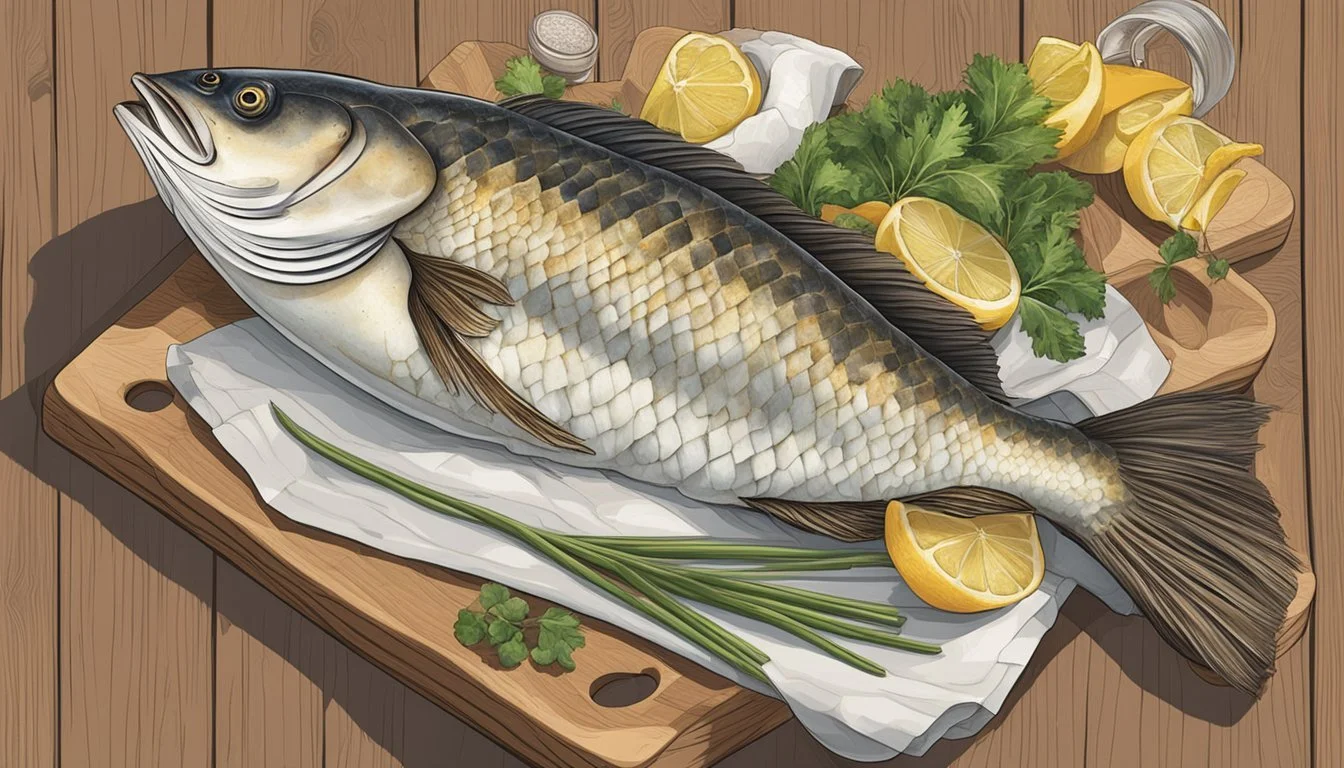Monkfish Substitutes
Top Alternatives for Your Recipes
For those seeking alternatives to monkfish, a variety of substitutes offer similar flavors and textures. Cod is an excellent option due to its flaky yet firm texture, making it suitable for many recipes that call for monkfish. Other white fish like halibut and haddock also serve as great alternatives, providing a dense and firm meat that holds up well in cooking.
Lobster, while different in physical form, shares a comparable richness and sweetness with monkfish, making it a luxurious substitute in dishes. Meanwhile, red snapper is a milder choice that still provides a pleasant firm texture, ideal for sautés and curries.
Plant-based substitutes such as tofu and tempeh offer high-protein alternatives for those looking to avoid seafood altogether. These options, though different in texture, can still create satisfying dishes while providing essential nutrients.
Understanding Monkfish
Monkfish, also known as anglerfish or goosefish, are a type of Lophius species found primarily in the North Atlantic and Atlantic Ocean. Often referred to as "sea-devil" due to its unusual appearance, the monkfish is prized for its mild flavor and unique texture.
The texture of monkfish is firm and meaty, resembling that of lobster. This makes it a versatile choice in cooking, retaining its consistency even after various methods of preparation.
Flavor and Culinary Uses
Monkfish has a mild, slightly sweet flavor that absorbs other seasonings well, making it suitable for a wide range of recipes.
Nutritional Highlights
Rich in Protein
Low in Fat
Cooking Methods
Monkfish can be prepared using multiple cooking methods:
Grilling
Baking
Sautéing
Poaching
These methods help enhance its natural flavors while keeping the texture intact.
Key Identifiers
Firm, white flesh
Slightly sweet taste
Monkfish remains a favorite among seafood lovers due to its versatility and appealing taste profile. Whether grilled, baked, or sautéed, it holds a special place in various culinary traditions.
Importance of Substitutes
Finding substitutes for monkfish is essential for numerous reasons.
Availability: Monkfish may not be available in all regions. Having substitutes like cod or halibut ensures that recipes can be made even when monkfish is not accessible.
Sustainability: Overfishing has led to concerns around the sustainability of certain fish species, including monkfish. Using alternatives like tofu for vegetarian dishes or red snapper can reduce demand and promote sustainable fishing practices.
Expense: Monkfish can be expensive. Substitutes such as haddock or sea scallops provide more affordable options while maintaining a similar texture and flavor profile.
Dietary Preferences: Some people might prefer not to eat monkfish due to dietary restrictions or personal choices. Options like tempeh or seitan cater to vegans and vegetarians without compromising on the dish's integrity.
Additionally, using a variety of substitutes can enhance culinary creativity, allowing chefs to experiment with different textures and flavors. This can lead to discovering new favorite dishes while maintaining the intended qualities of the original recipe.
Popular Monkfish Substitutes
Selecting a substitute for monkfish involves considering both seafood and plant-based options with similar textures and flavors. Below, we explore some excellent choices for those seeking alternatives to monkfish.
Seafood Substitutes
1. Grouper:
Grouper offers a mild, sweet flavor and a meaty texture, making it a strong contender for replacing monkfish. It can be cooked in several ways, including grilling, baking, and pan-searing.
2. Atlantic Cod:
Atlantic cod is a versatile white fish with a flaky yet firm texture. This makes it suitable for dishes that normally call for monkfish. It is particularly good for recipes where a lighter fish is preferred.
3. Halibut:
Halibut is known for its dense and firm meat, closely mimicking the hearty quality of monkfish fillets. This fish holds up well in various cooking methods like grilling and baking, maintaining its structure and flavor profile.
4. Red Snapper:
Red snapper is a mild, sweet fish with a pleasant firm texture. It is ideal for those who prefer a less intense fish flavor. Well-suited for sautéing or incorporating into pies and curries, red snapper’s skin crisps nicely when cooked.
5. Scallops:
Scallops may not be fish, but their sweet flavor and tender texture can sometimes serve as a good stand-in for monkfish, especially in dishes like stews or seafood medleys.
Vegetarian and Vegan Substitutes
1. Tofu and Firm Tofu:
Tofu, especially the firm variety, can effectively substitute monkfish in vegan and vegetarian dishes. When marinated and cooked, it provides a chewy texture that works well in various recipes.
2. Tempeh:
Tempeh offers a firm texture and a slightly nutty flavor, which makes it a suitable option. It can be sliced, marinated, and used in dishes that traditionally require monkfish.
3. Mushrooms:
Certain mushrooms, like king oyster mushrooms, have a meaty texture that can mimic monkfish. Their ability to absorb flavors makes them a versatile choice in plant-based diets.
4. Jackfruit:
Jackfruit provides a stringy texture that, when prepared correctly, can resemble the texture of monkfish. It is particularly effective in dishes like fish tacos or seafood stews, providing a suitable vegan substitute.
Cooking Techniques for Substitutes
Various cooking techniques help achieve the best results when using monkfish substitutes. Each method brings out unique flavors and textures that can enhance the dish.
Baking and Roasting
Baking and roasting are ideal for firm-textured substitutes like red snapper and grouper. These methods allow for even cooking and can enhance natural flavors. Preheat the oven to 375°F (190°C), then place the seasoned fish on a baking sheet lined with parchment paper. For added flavor, drizzle with olive oil or dot with butter.
Roasting at a high temperature, around 425°F (220°C), can create a crispy outer layer while keeping the interior moist. Consider adding vegetables like cherry tomatoes or asparagus to the baking sheet. This technique works well for Atlantic cod, too.
Grilling and Broiling
Grilling and broiling can bring out a smoky flavor and beautifully charred exterior. Red snapper and grouper are excellent choices for these techniques. Preheat the grill to medium-high and oil the grate to prevent sticking. Brush the fish with olive oil and season with salt, pepper, and herbs.
Grilling should take about 4-5 minutes per side, depending on the thickness. For broiling, place the fish on a broiler pan and cook for 5-6 minutes per side. Keeping the fish firm and succulent, these methods are perfect for summer meals.
Pan-Searing and Frying
Pan-searing and frying create a deliciously crispy outer crust. Choose a heavy skillet and heat it over medium-high heat with olive oil or butter. For monkfish substitutes like cod, season the fillets, then place them in the hot skillet. Sear each side for 3-4 minutes until golden brown.
For frying, coat the fish in a light batter or seasoned flour before placing it in oil heated to 350°F (175°C). Fry each piece for around 3-5 minutes until crisp and golden. Both methods enhance the texture and flavor, making them crowd favorites.
Steaming and Poaching
Steaming and poaching are gentle cooking techniques that maintain moisture and subtle flavors. Use a steaming basket over boiling water, seasoning the fish with herbs and spices. Steaming is ideal for delicate substitutes like cod, taking about 8-10 minutes depending on the thickness.
Poaching involves simmering the fish in a flavorful liquid, such as a court bouillon or broth. Heat the liquid to just below boiling, then add the fish. Poach for 5-7 minutes or until the fish flakes easily. This method is especially great for maintaining a tender texture.
Flavor Pairings and Seasonings
Monkfish pairs well with a variety of seasonings and flavors due to its mildly sweet, firm flesh.
Herbs like basil and thyme enhance the fish's natural taste. Mediterranean flavors, such as a mix of garlic, lemon, and olive oil, bring out a robust aroma and add depth to the dish.
Spices such as paprika and cumin provide a gentle kick. Acid from lemon juice or vinegar can brighten the fish's flavor. A simple marinade of olive oil, lemon juice, garlic, and fresh herbs is highly effective.
To make the most of monkfish's sturdy texture, brushing it with melted butter and seasoning with salt and pepper is always a good choice. Adding a sprinkling of chopped parsley at the end gives a fresh, vibrant finishing touch.
Substitute-Inclusive Recipes
In dishes where monkfish is typically used, substitutions like cod, red snapper, and halibut can replicate the desired texture and flavor. Here are a few applications in different cuisines.
Mediterranean Dishes
For Mediterranean recipes, monkfish substitutes can include cod and red snapper.
In traditional paella, cod's flaky texture is a suitable stand-in for monkfish. Its mild flavor blends well with saffron, bell peppers, and peas.
For bouillabaisse, red snapper works effectively. Its firm flesh holds up well in the stew, absorbing the flavors of garlic, tomatoes, and fennel.
Halibut is another good choice for Mediterranean fish soups. Its dense meat ensures that it doesn't fall apart during the cooking process.
American Classics
In American cuisine, versatile substitutes like Atlantic cod and halibut work well.
Atlantic cod is ideal for New England fish chowder, providing the mild flavor and firm texture similar to monkfish. It also complements the creamy broth of potatoes and onions.
For fish tacos, red snapper's sweetness pairs nicely with cilantro, lime, and avocado. Grilled snapper fillets can easily be flaked into tacos, retaining their texture.
Halibut's hearty nature makes it suitable for pan-seared dishes served with garlic butter or herbs. Its firmness allows it to be cooked without breaking apart.
Asian-Inspired Cuisine
Asian recipes benefit from these fish substitutes when monkfish is unavailable.
In Thai curry, cod or halibut can replace monkfish, as their firm texture holds up in rich coconut milk and spicy curry sauces. They absorb the flavors well, enhancing the dish.
Red snapper is excellent for Japanese tempura. Its mild taste and firm texture are ideal for battering and frying, resulting in a crisp exterior and tender interior.
For Chinese-style steamed fish, halibut is a great option. Its dense flesh absorbs the soy sauce, ginger, and scallions, maintaining its integrity during steaming.
Each of these substitutions ensures that the recipes retain their culinary appeal while making the most of available ingredients.
Nutritional Value and Health Benefits
Monkfish is well-regarded for its high nutritional value and numerous health benefits. It is an excellent source of high-quality proteins, which are essential for muscle repair and overall body function.
Monkfish is rich in omega-3 fatty acids, which support cardiovascular health and reduce inflammation. These beneficial fats also play a crucial role in brain function and development.
The fish is packed with essential vitamins and minerals:
Vitamin B12: Crucial for nerve function and the production of DNA.
Niacin (Vitamin B3): Supports metabolism and helps maintain healthy skin.
Selenium: An antioxidant that helps protect cells from damage.
Phosphorus: Important for healthy bones and teeth.
The following table highlights some key nutrients found in monkfish:
Nutrient Amount per 100g Protein 16.2g Omega-3 fatty acids 0.5g Vitamin B12 2.4 mcg Niacin 2.8 mg Selenium 36 mcg Phosphorus 200 mg
Consuming monkfish can contribute to muscle health, enhanced cognitive function, and improved immune system performance. Its low fat content makes it an excellent choice for those looking to maintain a balanced diet without high cholesterol levels.
Culinary Tips for Preparing Substitutes
Cod is a versatile substitute for monkfish. It has a flaky yet firm texture. Marinate lightly with an acidic marinade like lemon juice to enhance its mild flavor. Use methods such as grilling, poaching, or pan-searing to prevent the fish from crumbling.
Red Snapper offers a mild, sweet taste and a pleasant firm texture. It is excellent for sautéing, where the skin crisps nicely. Smaller pieces hold up well in pies and curries. Opt for minimal seasoning to allow its natural flavors to stand out.
Halibut provides dense, firm meat, making it a suitable replacement. Its hearty quality replicates monkfish well. For best results, bake or grill to maintain moisture and texture. Use umami-rich marinades to deepen the flavor profile.
Striped Bass also works as a substitute. It features a delicate yet firm texture that holds up under various cooking techniques. Marinating with herbs and spices enhances its mild taste. Create a balance by avoiding excessive use of acidic ingredients.
Sturgeon is another option. Its firm texture is ideal for grilling and searing. Due to its rich flavor, light seasoning or simple acidic marinades are recommended. Avoid overcooking to maintain its moisture and texture.
For vegetarian options, consider plant-based alternatives. Techniques such as searing, grilling, or baking help achieve a satisfying, firm texture. Utilize marinades to allow the ingredients to absorb seasonings effectively, enhancing their flavor profiles.
Exploring Alternatives in Different Cuisines
When considering substitutes for monkfish in various cuisines, several options provide similar textures and flavors.
Mediterranean Cuisine
In Mediterranean dishes, halibut and black cod are preferred substitutes for monkfish due to their dense, firm meat. Tiltapia and hake can also be used for a lighter texture.
Vegan and Vegetarian Options
For vegetarian and vegan alternatives, tofu and tempeh offer high protein content, while mushrooms provide rich fiber and minerals. Jackfruit is another popular option, particularly in recipes that require a tender, flaky texture.
Asian Culinary
Pacific cod and orange roughy work well in Asian culinary traditions, offering a firm texture suitable for a variety of cooking methods, from steaming to frying.
American Cuisine
In American recipes, mahimahi and tilapia are common monkfish substitutes. These fish types are versatile and hold up well in grilling and baking. Crab and shrimp can be used in seafood-heavy dishes to maintain a similar taste profile.
Here's a quick comparison:
Substitute Texture Best For Halibut Firm Mediterranean dishes Black Cod Dense Mediterranean dishes Tofu High Protein Vegan/Vegetarian Tempeh High Protein Vegan/Vegetarian Mushrooms Rich Fiber Vegan/Vegetarian Pacific Cod Firm Asian dishes Orange Roughy Firm Asian dishes Mahimahi Versatile American dishes Tilapia Versatile American dishes Crab Similar Taste Seafood dishes Shrimp Similar Taste Seafood dishes
Knowing the characteristics of monkfish and its substitutes helps in selecting the right ingredient for any culinary adventure.









